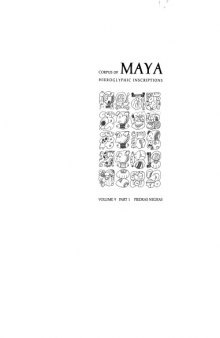دانلود کتاب Corpus of Maya Hieroglyphic Inscriptions 9.1 (Piedras Negras)
by David Stuart, Ian Graham|
|
عنوان فارسی: علامت هیرنگلیفیک 9.1 مایا (پیدراس نگراس) |
 دانلود کتاب
دانلود کتاب
 جزییات کتاب
جزییات کتاب
Travel to Piedras Negras has always been difficult, given its isolated location and the nearby stretches of the river that are often made impassable by rapids. The principal and most reliable route of access to the ruins is a longused trail running from the Mexican border to the north. The trail was originally opened in the late 1800s by laborers from Tenosique, Mexico, to provide access to various lumber camps, or monterias, located along the river. It originally extended as far as the encampment opposite El Cayo (Desempefio), some ten kilometers south of Piedras Negras. The trail to Piedras Negras has remained a customary means of access for archaeologists, looters, and adventurous tourists up to the present day.
If opting for this route, one may drive from Tenosique on good gravel and dirt roads southward to the border community of Corregidora Ortiz, where a Mexican military checkpoint monitors the comings and goings of visitors into the site (as of 1999 Guatemala had no official presence on this border). Here the drivable road ends, and one must then leave vehicles and continue on foot, crossing the border into Guatemala. During the dry season (generally March through the end of May), the hike from this point into Piedras Negras takes about five or six hours. The forested trail follows a northwest-southeast direction along a generally flat valley that roughly parallels the Rio Usumacinta. Approximately eleven kilometers from the border, the trail comes close to the river at El Porvenir, once the site of a rnonteria encampment, and there passes several small mounds. The route continues for a few kilometers over somewhat more difficult terrain and enters Piedras Negras at the West Group Plaza, in front of Structure K-S.
Here it is still possible to see the rusting remains of a 1930s vintage tractor that was driven to the ruins along the same trail (amazing as it now seems) by the University of Pennsylvania project.
Access to Piedras Negras by river is also possible, but again not easy. Assuming that the rapids above are passable, large wooden lanchas with outboard motors and experienced pilots can make the trip from various locales upstream, such as Bethel in Guatemala or Frontera Corozal, in Mexico. Private tour groups and rafting outfitters have at times made scheduled trips along the Usumacinta, usually stopping to camp at Piedras Negras.
Archaeological remains in the vicinity of Piedras Negras include EI Porvenir, just mentioned, and the site of EI Cayo to the south. The latter evidently had close political connections to Piedras Negras in ancient times. The poorly known centers of Budsilha and La Mar, first documented by Teobert Maler over a century ago (Maler 1903, pp. 89-96), are located in Mexico to the west, near the Rio Budsilha, which empties into the Usumacinta over impressive waterfalls about ten kilometers downstream from Piedras Negras. The surrounding Guatemalan territory remains virtually unknown to archaeologists but reportedly includes several significant ruins.









 این کتاب رو مطالعه کردید؟ نظر شما چیست؟
این کتاب رو مطالعه کردید؟ نظر شما چیست؟
